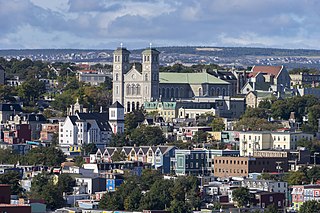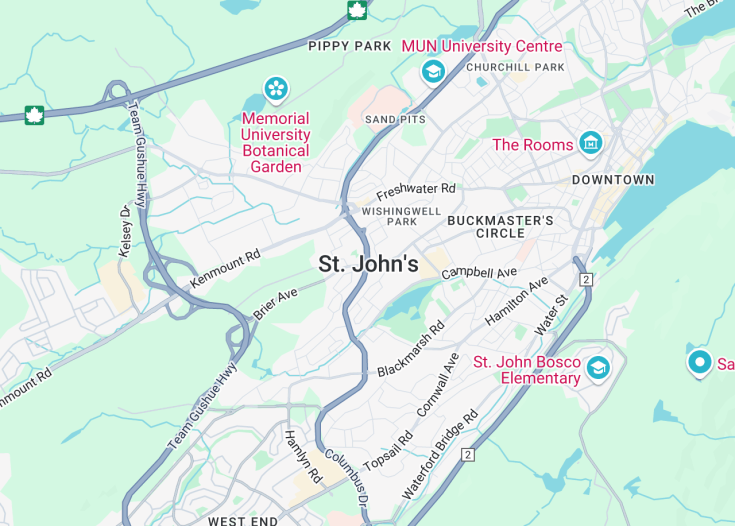St. John’s, the vibrant capital of Newfoundland and Labrador, offers a unique blend of traditional charm and modern vibrancy. With its colorful row houses, historic landmarks, and breathtaking coastal views, St. John’s serves as a gateway to the rich cultural heritage and natural beauty of the region. Tourists can delve into the city’s storied past, enjoy local culinary delights, and explore the rugged landscapes that have inspired artists and adventurers alike.
Don’t miss experiencing the famous Signal Hill National Historic Site, where you can enjoy panoramic views of the Atlantic and learn about the city’s military history.
Pack layers and waterproof gear regardless of the season, as the weather in St. John’s can be quite unpredictable, maintaining your comfort as you explore.
St. John’s: A Vibrant Coastal Gateway
| Country | Newfoundland and Labrador (Canada) |
| Time in St. John’s | GMT-3:30 |
| Language spoken | English |
| Population | 108,860 (Statistics Canada, 2021 Census) |
| Currency | Canadian Dollar (CAD $) |
| Airports | St. John’s International Airport (6 mi / 9.7 km). |
St. John’s, the capital city of Newfoundland and Labrador, captivates visitors with its rich maritime history and vibrant local culture. Situated on the eastern tip of the Avalon Peninsula, it serves as both a traditional and contemporary center, intertwining its past with the energies of a bustling modern city. As one of the oldest cities in North America, St. John’s is famously known for its colorful row houses and its steep streets that offer scenic views of the Atlantic Ocean.
History buffs delight in exploring the storied past of St. John’s which includes its role in transatlantic communications; notable locations include Signal Hill, where Guglielmo Marconi received the first wireless transatlantic message in 1901. The city’s proximity to prolific fishing grounds historically made it a strategic port during the age of sail, a time when St. John’s streets thrummed with sailors from around the globe.
Today, St. John’s is more than just a historical treasure. It’s an arts hub, with numerous galleries, theatres, and live music venues enriching its cultural landscape. The city famous for its George Street, hosts an annual George Street Festival, attracting visitors keen to experience its lively nightlife with its multitude of bars and pubs—one of the highest concentrations of establishments per capita of any North American city. Nature plays a significant role in local life as trails and natural reserves such as the East Coast Trail offer stunning vistas and accessible wildlife experiences, making it a prime location for bird watchers and nature enthusiasts.
The economy of St. John’s is largely driven by the ocean industries and educational institutions, notably Memorial University of Newfoundland, which attracts students from across the globe. Such factors make the city an attractive place to work and live with its combination of scenic beauty, historic wonders, and economic opportunities.
Where is St. John’s?
Located on the southeastern coast of the island of Newfoundland, St. John’s is known for its strategic position in the North Atlantic.
Distances:
| Route | Distance by car | Time by car |
| Corner Brook to St. John’s | 439 mi (707 km) | Approx. 9 hours |
| Gander to St. John’s | 205 mi (330 km) | Approx. 4 hours |
What is St. John’s famous for?
St. John’s is famous for its vibrant arts scene, historical significance, and the bustling George Street, filled with pubs and music venues, making it the nightlife capital of Newfoundland.
History
Pre-European Contact (Before 1497)
St. John’s, the capital city of Newfoundland and Labrador, Canada, bears a rich history that stretches back thousands of years. Long before European explorers made footprints, the region was inhabited by indigenous groups, including the Beothuk and Dorset cultures. These early inhabitants were primarily engaged in fishing and hunting, utilizing the rich marine resources offered by the Atlantic waters surrounding what would eventually be known as St. John’s.
Age of Exploration and Settlement (1497 – 1600)
St. John’s claims the title of the oldest English-founded city in North America, thanks to John Cabot, who allegedly landed in Newfoundland in 1497. Though it is not definitively proven that Cabot landed specifically at St. John’s, the city’s harbor served as a key entry point for European fishers and explorers. By the early 16th century, it had become a bustling center for the fishing industry, which attracted settlers from England and Ireland who established a permanent community.
Colonial Growth and Conflict (1601 – 1800)
Throughout the 17th and 18th centuries, St. John’s significance as a naval base grew, primarily due to its strategic location. The city witnessed several military actions, including raids by French troops and conflicts between European powers vying for control over the lucrative fishing grounds. The 1696 French attack resulted in the destruction of the settlement, but it was swiftly rebuilt. St. John’s served as a key naval base during the Seven Years’ War and American Revolutionary War, highlighting its military importance in the Atlantic.
Economic Expansion and Modernization (1801 – Present)
The 19th and 20th centuries marked a period of significant growth and modernization for St. John’s. The fishing industry continued to be the backbone of its economy, but the city also evolved into a commercial hub. The establishment of transatlantic communication cables and the expansion of shipping industries contributed to its economic expansion. Despite challenges such as the Great Fire of 1892, which devastated large parts of the city, St. John’s continued to grow resiliently, transitioning smoothly into the 21st century as a vibrant urban center with a focus on diverse economic sectors including tourism, technology, and offshore oil industries.
Visit St. John’s
What to see and do in St. John’s, Newfoundland and Labrador (Canada).
Visitors to St. John’s will find a colorful city brimming with history, culture, and natural beauty. The iconic rows of brightly painted houses, known as “Jellybean Row,” make for a picturesque stroll. The city’s oldest area, Signal Hill, offers panoramic views of the Atlantic Ocean and is a perfect spot for hiking and picnicking. The Rooms, housing a museum, art gallery, and archives, provide insights into the rich cultural heritage of Newfoundland and Labrador. For those interested in marine life, the nearby Cape Spear Lighthouse, the easternmost point in North America, showcases breathtaking coastal scenery and historical exhibits.
- Explore the coastal trails along Signal Hill.
- Visit The Rooms for a dive into local history and culture.
- Experience the vibrant atmosphere of George Street.
- See the historic Cape Spear Lighthouse.
Events in St. John’s
St. John’s is host to numerous events throughout the year, celebrating everything from its maritime history to contemporary culture. The Royal St. John’s Regatta, held on the first Wednesday in August, is North America’s oldest annual sporting event. The city comes alive during the George Street Festival, which takes place in late July, featuring live music, entertainment, and local cuisine. The Newfoundland and Labrador Folk Festival, a celebration of traditional music and crafts, draws crowds in early August.
Best time to visit St. John’s
The best time to visit St. John’s is during the summer months, from June to August, when the weather is mild and most festivals take place. This period offers the most pleasant temperatures for exploring the outdoor attractions and enjoying the city’s many outdoor events.
Is St. John’s worth visiting?
St. John’s is undoubtedly worth visiting for anyone interested in experiencing a unique blend of rich history, vibrant cultural scenes, and stunning coastal landscapes. The city offers a plethora of activities and sights for all ages, making it a great destination for both educational trips and leisurely vacations. Whether you’re a history buff, nature lover, or cultural enthusiast, St. John’s provides a memorable and enriching experience.









